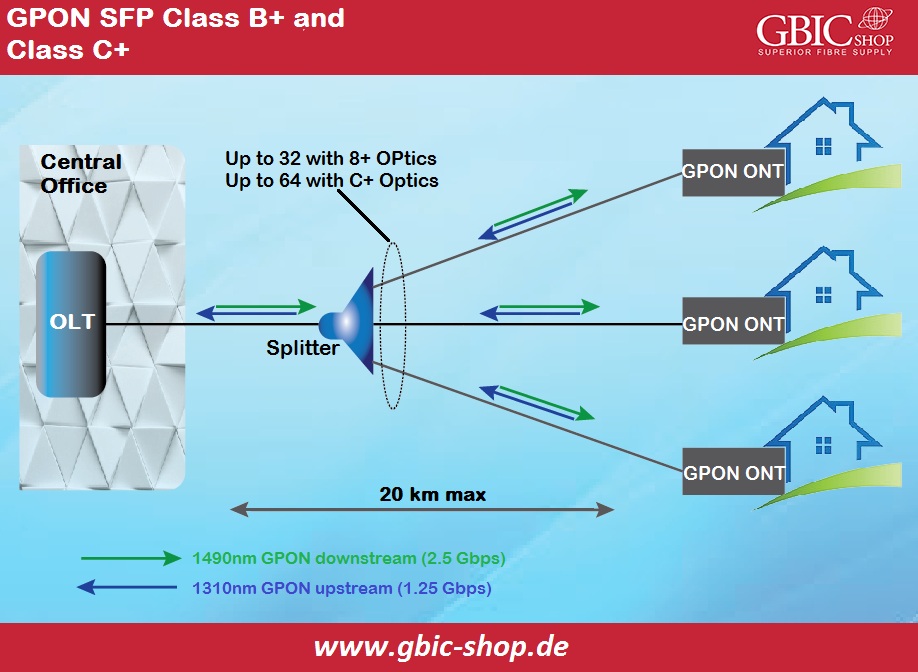GPON stands for Gigabit Passive Optical Network. It is one of the leading technologies that we use in fiber-based access networks, which include FTTH (Fiber to the Home), FTTB (Fiber to the Business), FTTC (Fiber to the Curb), etc. The GPON system consists of two main active communication elements, which we call OLT (Optical Line Termination) and ONT (Optical Network Termination) or ONU (Optical Network Unit). Current ONT/ONU and OLT use compact optical modules to achieve the triple-play benefits of GPON. We know these modules as GPON SFP optical transceivers. In this article, a complete presentation of GPON SFP optical transceivers is given.
A DESCRIPTION OF GPON SFP:
GPON SFP is a type of gigabit fiber optic transceiver that we use in the GPON system and is adapted to the ITU-T G.984.2 standard. It is a BIDI (bi-directional) module that has an SC connector and works with a simplex SMF cable. A GPON SFP transceiver transmits and accepts signals of different wavelengths between the ONT on the end user side and the OLT on the exchange side. GPON SFPs use both downstream and upstream data via fiber optic WDM.

GPON SFP: DIFFERENCES BETWEEN CATEGORY B+ AND CATEGORY C+:
We can categorize GPON SFP modules into optical line termination SFP (OLT SFP) and optical GPON network termination SFP (ONT SFP) or optical GPON network unit SFP (ONU SFP) based on the devices they use. There are also category B+ GPON SFP and category C+ GPON SFP. The main differences between them are the receive sensitivity and transmit power. The table below lists the Rx sensitivity and Tx power of category B+ and C+ GPON SFP.
.jpg)
By using category B+ or C+ GPON OLT SFP, up to 32 or 64 ONTs can be used consecutively in the user's premises. Also, we can use a C+ category OLT SFP with a B+ category ONT SFP because the loss budget of the link is favorable.
.jpg)
DIFFERENCE BETWEEN GPON SFP AND CONVENTIONAL BIDI SFP:
GPON SFP is part of the bidirectional Gigabit SFP family, but differs from the "usual" bidirectional optical SFP transceivers and the optical GPON SFP transceivers.
SIGNAL TRANSMISSION MODE:
With the conventional bidirectional SFP transceivers that we mostly use in the backbone network, the fiber optic communication mode is a point-to-point mode, i.e. we have to use them in matched pairs. A bidirectional transceiver usually has an LC connector instead of an SC connector. Here is a picture of the P2P (point to point) transmission mode.
Communication between GPON OLT SFP and GPON ONU SFP takes place in the exchange using optical splitters. The communication mode of GPON SFP is P2MP (point to multi-point). Therefore, a GPON substructure has the shape of a tee or a tree.
.jpg)
TRANSMISSION RANGE:
The communication range of conventional bidirectional Gigabit lines is up to 160 kilometers over SMF using wavelengths of 1590 nanometers/1510 nanometers and 1510 nanometers/1590 nanometers. GPON ONT/ONU and OLT SFP optical transceivers support a communication range of up to 20 kilometers with 1490 nanometers/1310 nanometers and 1310 nanometers/1490 nanometers wavelengths.
ADVANTAGES OF USING GPON SFP:
GPON SFP is a cost-effective and more convenient solution for end users. In addition, it also reduces the number of devices that the ISP (Internet Service Provider) needs to deploy. Before the introduction and use of GPON ONT SFP in GPON networks, the ISP had to install a fiber optic modem and router for Internet access, and if we need IPTV services, we may also need a video recorder or set-top box. The separation of the various devices automatically increases the price of GPON services.
The modern GPON SFP is small and combines triple-play services. It also has a lower consumption. The ISP provides the user with a GPON ONT SFP. We usually install this module in the hub. The user can also pull out the optical patch cable and the GPON ONT SFP from the ISP's router. He can then plug them into the router that the ISP has whitelisted.
Conclusion:
In GPON fiber optic networks, GPON SFP optical transceivers are generally used in the two primary active communication elements ONT/ONU and OLT. They are necessary to ensure high bandwidth connections between end users and service providers over a range of up to 20 kilometers. We can categorize GPON SFP into B+ and C+, with the main differences being Rx sensitivity and Tx performance. This module has clarified the use of GPON services. It offers some benefits to both end users and service providers.
 English
English
 Deutsch
Deutsch
 Espaniol
Espaniol










